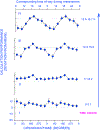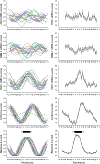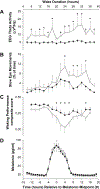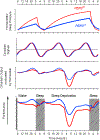Circadian and Homeostatic Regulation of Human Sleep and Cognitive Performance and Its Modulation by PERIOD3
- PMID: 33162871
- PMCID: PMC7644166
- DOI: 10.1016/j.jsmc.2009.02.001
Circadian and Homeostatic Regulation of Human Sleep and Cognitive Performance and Its Modulation by PERIOD3
Figures





Similar articles
-
Sleepiness and Cognitive Performance among Younger and Older Adolescents across a 28-Hour Forced Desynchrony Protocol.Sleep. 2015 Dec 1;38(12):1965-72. doi: 10.5665/sleep.5250. Sleep. 2015. PMID: 26194564 Free PMC article.
-
Period3 VNTR polymorphism influences the time-of-day pain onset of acute myocardial infarction with ST elevation.Chronobiol Int. 2014 Oct;31(8):878-90. doi: 10.3109/07420528.2014.921790. Epub 2014 May 27. Chronobiol Int. 2014. PMID: 24866331
-
Investigating the interaction between the homeostatic and circadian processes of sleep-wake regulation for the prediction of waking neurobehavioural performance.J Sleep Res. 2003 Sep;12(3):181-7. doi: 10.1046/j.1365-2869.2003.00357.x. J Sleep Res. 2003. PMID: 12941057
-
Phenotyping of neurobehavioral vulnerability to circadian phase during sleep loss.Methods Enzymol. 2015;552:285-308. doi: 10.1016/bs.mie.2014.10.024. Epub 2014 Dec 26. Methods Enzymol. 2015. PMID: 25707282 Review.
-
Circadian modulation of sleep in rodents.Prog Brain Res. 2012;199:203-218. doi: 10.1016/B978-0-444-59427-3.00012-5. Prog Brain Res. 2012. PMID: 22877667 Review.
Cited by
-
Age-related changes in sleep and circadian rhythms: impact on cognitive performance and underlying neuroanatomical networks.Front Neurol. 2012 Jul 26;3:118. doi: 10.3389/fneur.2012.00118. eCollection 2012. Front Neurol. 2012. PMID: 22855682 Free PMC article.
-
Sleep Delta power, age, and sex effects in treatment-resistant depression.J Psychiatr Res. 2024 Jun;174:332-339. doi: 10.1016/j.jpsychires.2024.04.028. Epub 2024 Apr 17. J Psychiatr Res. 2024. PMID: 38697012 Free PMC article.
-
Timing of Deep and REM Sleep Based on Fitbit Sleep Staging in Young Healthy Adults under Real-Life Conditions.Brain Sci. 2024 Mar 6;14(3):260. doi: 10.3390/brainsci14030260. Brain Sci. 2024. PMID: 38539648 Free PMC article.
-
Disrupted Circadian Rhythms and Substance Use Disorders: A Narrative Review.Clocks Sleep. 2024 Aug 19;6(3):446-467. doi: 10.3390/clockssleep6030030. Clocks Sleep. 2024. PMID: 39189197 Free PMC article. Review.
-
Sleep Patterns, Eating Behavior and the Risk of Noncommunicable Diseases.Nutrients. 2023 May 25;15(11):2462. doi: 10.3390/nu15112462. Nutrients. 2023. PMID: 37299426 Free PMC article. Review.
References
-
- Achermann P, Borbély AA. Simulation of daytime vigilance by the additive interaction of a homeostatic and a circadian process. Biol Cybern 1994;71115–121. - PubMed
-
- Adam M, Retey JV, Khatami R, Landolt HP. Age-related changes in the time course of vigilant attention during 40 hours without sleep in men. Sleep 2006;29(1):55–57. - PubMed
-
- Aeschbach D, Sher L, Postolache TT, Matthews JR, Jackson MA, Wehr TA. A longer biological night in long sleepers than in short sleepers. J Clin Endocrinol Metab 2003;88(1):26–30. - PubMed
-
- Archer SN, Robilliard DL, Skene DJ, Smits M, Williams A, Arendt J et al. A length polymorphism in the circadian clock gene Per3 is linked to delayed sleep phase syndrome and extreme diurnal preference. Sleep 2003;26(4):413–415. - PubMed
Grants and funding
LinkOut - more resources
Full Text Sources
